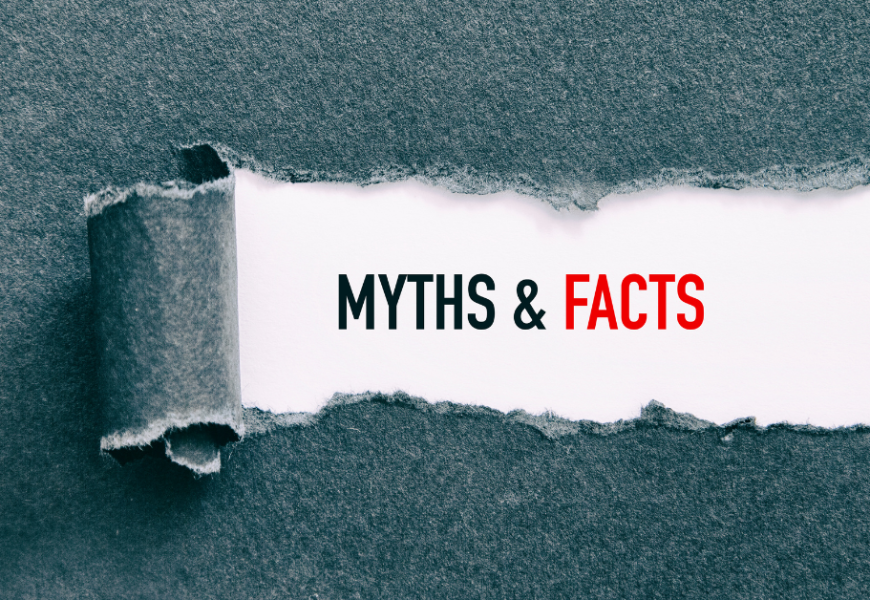When purchasing an auto policy, it’s essential to understand the factors that affect your policy costs and coverage. Unfortunately, a lot of misinformation passes for “common wisdom.” Here, we separate myths from facts about car insurance to help you make better decisions.
Myth 1 – Color Determines the Price of Auto Insurance
It doesn’t matter whether your car is “Arrest Me Red” or “Hide In Plain Sight White”—the color doesn’t factor into your auto insurance costs. The price of your auto policy is based on many factors, such as car make, model, body type, engine size and the age of the vehicle, as well as the car’s sticker price, the cost to repair it, its overall safety record and the likelihood of theft. Insurers also consider the driver’s age, driving record and sometimes credit history.
Myth 2 – It Costs More to Insure Your Car When You Get Older
Quite the opposite, in fact—older drivers may be eligible for special discounts. For example, those over the age of 55 can get a reduction in their auto insurance premium if they successfully complete an accident prevention course (available through local and state agencies and through AAA and AARP). Retirees or those who aren’t employed full-time—and therefore, driving less—may also be eligible for a car insurance discount. Older driver programs and discounts vary by state and insurance carrier, so if you think you may qualify, check with your insurance professional.
Myth 3 – Your Credit Has No Effect on Your Insurance Rate
Your credit-based insurance score—which is derived from your credit history—may matter. A good credit score demonstrates how well you manage your financial affairs and predicts whether someone is more likely to file an insurance claim. Many insurance companies consider it when you want to purchase, change or renew your auto insurance coverage. People with good credit—and, therefore, good insurance scores—often pay less for insurance.
Myth 4 – Your Insurance Will Cover You If Your Car Is Stolen, Vandalized, or Damaged by Falling Tree Limbs, Hail, Flood, or Fire
This is true if you opt for Comprehensive coverage, otherwise known as “Other than Collison,” on your personal auto insurance policy. Comprehensive coverage protects against things that collision does not, such as theft, vandalism, fallen trees, flood and fire.
Myth 5 – You Only Need the Minimum Amount of Auto Liability Insurance Required by Law
Almost every state requires you to buy a minimum amount of auto liability coverage, but buying only the minimum amount of liability means you are likely to pay more out-of-pocket for losses incurred after an accident—and those costs may be steep. The insurance industry and consumer groups generally recommend a minimum of $100,000 bodily injury protection per person and $300,000 per accident. If you have substantial personal financial assets to protect in the event of a lawsuit, you may even want to consider an umbrella liability policy.
Myth 6 – If Another Person Drives Your Car, Their Auto Insurance Will Cover the Damages
The actual answer to this question lies within the policy language. The priority of insurance coverage is determined based on how the policy contract reads. Never assume that the insurance coverage will come from the driver’s policy or the insurance will come from the policy of the vehicle being driven. Over the past several years, some insurance carriers have updated their policy language to include wording that places the driver’s policy as primary.
Myth 7 – Soldiers Pay More for Insurance Than Civilians
If you are in the military—regardless of which branch—you qualify for a discount on auto insurance. You’ll need to supply documentation that lists your name, rank, and the time you will be enlisted in the service (in some situations, you might be able to have your commanding officer make a phone call on your behalf). Shop around—some auto insurance companies provide discounts for former members of the military, as well as their families.
Myth 8 – Personal Auto Insurance Also Covers Business Use of Your Car
If you are self-employed and use your vehicle for business purposes, personal auto insurance may not protect you, so purchasing business vehicle insurance is essential. If you have other people—such as employees—using your vehicle, check their driving records regularly.
Myth 9 – Auto Dealerships Can Add a New Vehicle to the Customer’s Car Insurance
The policyholder is the only one who can authorize these changes to the policy. There is no coverage for the new vehicle until the policyholder provides proof of insurance (both the insurance card and declarations page). The policy will not be updated if they don’t receive the updated documents. It’s always best that the client contact the agency/carrier to update this information and ensure they receive the updated documents to confirm any changes.
At Howard Hanna Insurance, We Put You First
At Howard Hanna Insurance, we aim to provide accurate information and comprehensive coverage tailored to your needs. Don’t let common myths lead you astray—reach out to our knowledgeable agents today to get the facts and find the best auto insurance policy for you.
Ready to ensure you’re getting the best coverage at the right price? Contact Howard Hanna Insurance today for a personalized quote and see how we can help you drive with confidence. Visit our website or call us to get started.










